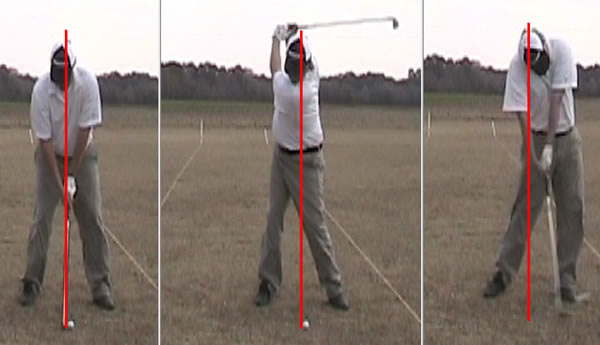
SNARES
3-F-7-0 (MACHINE ADJUSTMENT CHECK LIST)
Here Homer states that the 24 components of the stroke are what the machine should do. There are some indications and symptoms of maladjustment -- things is should not do. These maladjustments are called 'snares' in TGM.
3-F-7-A (STEERING)
Homer states that this is the number one malfunction, meaning it's the most common snare amongst golfers. Steering happens when the golfer tries to hold:
1. The Clubface square to the target line.
2. The Clubhead on the target line.
3. The Clubhed on a level or upward Angle of Attack.
Steering often feels like a lunging and/or an inability to 'release' the clubface thru impact. Steering almost always coincides with coming over the top and losing lag pressure very early on in the downswing.
Homer states:
A very successful and anti-steering therapy is an exaggerated 'inside-out' Cut Shot.As I've posted before, in TGM terms a cut shot is any time a golfer uses vertical hinging. So here the golfer would take a very inside-to-out swing path with a vertical hinge.
3-F-7-B (QUITTING)
Quitting is when the hands slow down or stop during the release. This is a very important snare to note because the this is usually a big reason why golfers flip thru impact.
Quitting is usually pretty easy to recognize if you have a camcorder or camera as at about impact the hands will be more in the middle of the legs or towards the rear leg. Here's a pic of a golfer steering.

Here's a pic of Tiger at impact, who obviously doesn't 'quit' his hands. See where his hands are, up by the left leg.

I find that quittin usually just before impact when the golfer stops wanting to move his hands and instead uses the right index to flip the wrists thru so the clubhead can make contact with the golf ball.
Homer states that 'quitting' results in:
1. A Bent Plane Line
2. A shortening of the swing radius (which decreases clubhead speed) and depending on Impact Hand location, this will result in either:
3. A 'down only' clubhead path (hitting it fat)
or
4. An 'Up and In' Clubhead path (clubhead should go down-out-forward) An 'up and in' results in a topped shot.
Homer states that quitting is impossible with proper and continuous rhymth. Here's a Lynn Blake video on 'rhythm.'
One of Homer's famous quotes in this book is here and it's SUSTAIN THE LAG. I like to talk a lot about lag pressure in this blog and its importance. My main feeling is that once you can feel lag pressure you should be able to finally 'get it' and reproduce lag pressure at impact on a consistent basis and get rid of the flip. Took me 20 years of golf, playing a highly competitive level, to understand lag pressure and it had a profound effect on my swing.
3-F-7-C (BOBBING)
Bobbing means the head raises and/or lowers throughout the swing. Paul Creamer is a 'bobber.' Homer states that this is due to faulty movement of the back or knees. People get a bit confused about the knees, but the knees play a huge part in the head movement because they are the foundation for the head. Bobbing disrupts the Shoulder-to-ball radius.
3-F-7-D (SWAYING)
'swaying' is incorrect weight shifting due usually to a faulty pivot. Swaying can happen in either directions. Swaying usually produces unorthodox trajectories, erratic timing and teetering balance. This is a very big part of what the Stack and Tilt method tries to eliminate. One thing I like about the Stack and Tilt is it eliminates lunging and makes balancing easier. But when you have shifted the weight for so many years there's still a tendency to want to have the weight more towards your right side at impact.
3-F-7-E
Homer states that all of these malfunctions basically are different ways of disrupting the same geometrical alignment of the downwards and outward arc of the Clubface. I tend to agree a lot with Lynn Blake's assessment that golfers tend to get the 'out and forward' part of the 'down-out-forward', but they usually never get quite enough 'down.'
The PGA Tour averages for Angle of Attack according to trackman are about -3.1* with a 3-iron and -5* with a PW. Your average golfer, who probably flips is usually at something like -1* with a 7-iron.
Homer also states that one of the problems golfers have is that they basically cut across the ball and often the way they combat that is to aim right and pull it back left. This is a compensation for earlier pulls to the left.
A good way to cure this is to stick an umbrella up out of the ground about 10 feet out in front of you. Then aim the clubface at the umbrella and your body parallel to the umbrella. But try and actually the ball to the right of the umbrella without opening the clubface. This will get you on a better path and help eliminate the over the top move.
3JACK
No comments:
Post a Comment